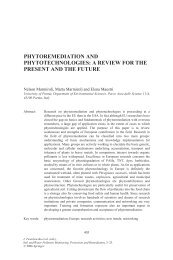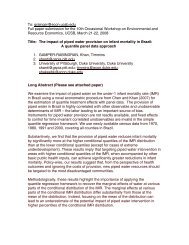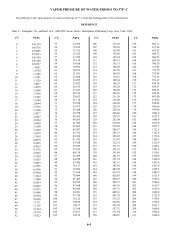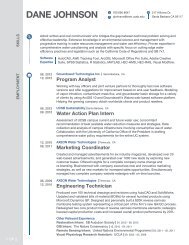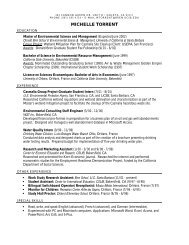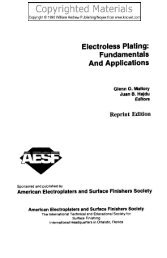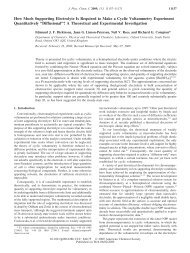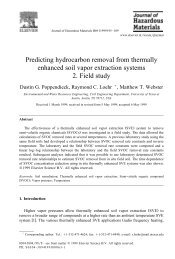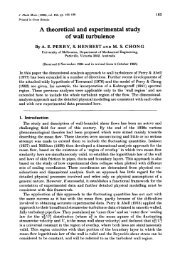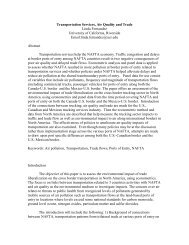anaerobic dehalogenation of halogenated organic compounds
anaerobic dehalogenation of halogenated organic compounds
anaerobic dehalogenation of halogenated organic compounds
You also want an ePaper? Increase the reach of your titles
YUMPU automatically turns print PDFs into web optimized ePapers that Google loves.
506 Max M. Häggblom et al.<br />
“halogen cycle” and are serving as a base for developing new methods for<br />
bioremediation <strong>of</strong> contaminated sediments.<br />
Key words:<br />
organohalide pollutants; contaminated sediments; <strong>anaerobic</strong> <strong>dehalogenation</strong>;<br />
polychlorinated dibenzo-p-dioxins; <strong>halogenated</strong> flame retardants<br />
1. INTRODUCTION<br />
Remediation <strong>of</strong> sediments contaminated with toxic chemicals is one <strong>of</strong> the<br />
greatest challenges when restoring estuaries and coastal salt marshes.<br />
Halogenated <strong>organic</strong> <strong>compounds</strong> constitute one <strong>of</strong> the largest and most<br />
problematic groups <strong>of</strong> environmental pollutants. These <strong>compounds</strong> are<br />
integral to a variety <strong>of</strong> industrial applications, including use as solvents,<br />
degreasing agents, biocides, pharmaceuticals, plasticizers, hydraulic and heat<br />
transfer fluids, intermediates for chemical synthesis, flame retardants and<br />
numerous other industrial functions. The majority <strong>of</strong> these <strong>compounds</strong> are<br />
chlorinated, but brominated, fluorinated and iodinated <strong>compounds</strong> are also<br />
used in industrial applications (Häggblom and Bossert, 2003). Their use has<br />
resulted in widespread dissemination and environmental contamination, with<br />
estuarine and marine sediments as significant sinks. Consequently, the<br />
management <strong>of</strong> marine and estuarine sediments contaminated with toxic<br />
<strong>organic</strong> <strong>compounds</strong>, including polychlorinated dibenzo-p-dioxins and<br />
dibenz<strong>of</strong>urans (PCDD/Fs), PCBs, pesticides and brominated flame<br />
retardants, is a major problem with far-reaching economic and ecological<br />
consequences.<br />
Microbial degradation is one <strong>of</strong> the key factors that determines the<br />
ultimate fate <strong>of</strong> organohalides in the environment, with cleavage <strong>of</strong> the<br />
carbon-halogen bond being one <strong>of</strong> the critical steps. Microbial degradation<br />
requires the presence <strong>of</strong> enzymes that cleave this bond under physiological<br />
conditions and microorganisms have evolved a variety <strong>of</strong> metabolic<br />
strategies for cleaving the carbon-halogen bond (for reviews, see Häggblom,<br />
1992; Häggblom and Bossert, 2003; Holliger et al., 2003; Löffler et al.,<br />
2003). Dehalogenation reactions comprise different strategies, where<br />
organohalides serve either as electron donors (and carbon sources) or as<br />
electron acceptors. In <strong>anaerobic</strong> sediments the most important process is one<br />
in which the organohalide serves as an alternate electron acceptor for<br />
<strong>anaerobic</strong> respiration, termed dehalorespiration. Microbial degradation <strong>of</strong><br />
organohalides in anoxic sediments is widely observed (Häggblom et al.,<br />
2000, 2003), although the availability <strong>of</strong> suitable electron donors and<br />
acceptors affects the biodegradability <strong>of</strong> organohalides. Anaerobic



